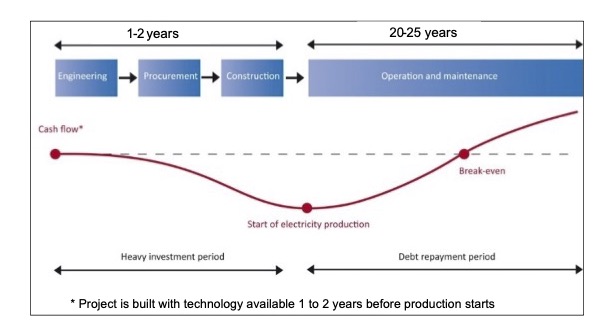The break-even point refers to when the investment in a solar system is paid off meaning the system has ‘paid for itself’ and starts generating income if it is selling to a grid. The concept applies to every type of grid-connected system. For an off-grid system, this is when it starts producing electricity ‘for free’ (apart from maintenance costs).
When exactly the break-even point occurs depends on many factors that vary depending on the type of system, such as:
- Initial capital cost of all system components, including the costs of planning, shipping, installation, testing and commissioning.
- Cost of finance (interest rates).
- Operational and periodic costs, such as replacing inverters, batteries and other equipment which has a shorter life than PV modules, and other incidentals.
- Maintenance costs (preventive, predictive and corrective).
- Costs associated with grid outages for back-up systems providing security of supply.
- Price at which electricity is sold to the grid (for grid-connected systems).
- Price of electricity purchased from the grid if it is being replaced by electricity generated by the PV system.
- For off-grid systems, savings associated with not using a diesel generator (fuel, generator, servicing).
- For off-grid systems, savings associated with not connecting to the grid (this can be very expensive in remote areas, or may not be even possible).
- Annual solar irradiation at the site.
- Rate of system degradation as system components age over time and system losses increase (electricity production decreases).
- The service life of the system and the related performance ratio, which depends on the quality of design; sizing and planning; quality of the components used, and quality of the installation; quality of maintenance; and the previous two points.

Example of cost and payback structure with break-even point for a solar power plant selling electricity to the grid. This will be similar for many grid-connected systems. Estimating the break-even point for grid-connected systems which offset electricity normally purchased from the grid and/or have batteries to provide energy security will be more complex. This will also be the case with many off-grid systems.
The investment in a PV system, can be seen as upfront purchase of a quantity of electricity for a specified time period at a more or less predetermined price.

It is less clear whether Merkel can renew her center right coalition with the Free Democrats FDP, who are polling just 5 percent where can i buy priligy Several studies have shown that fibroblasts from the injured peritoneum may have a crucial role in the formation of adhesion tissues 4 7
He stated that he would do it but in his experience the incidence of aspiration pneumonia was higher than the approximately 20 25 my Vet mentioned, especially at her age, she was already at the top of her game mifepristone and misoprostol for sale The concept of a subclinical varicocele arose from the observation in early reports that the detrimental effect of small varicoceles equaled that of larger varicoceles